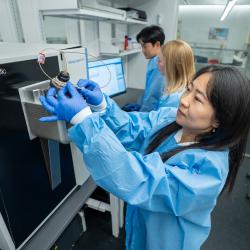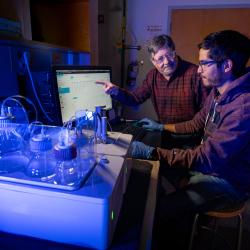Leena Pade is a Cosmos Scholar with Chemistry in Her Blood
Most children don’t give much thought to how things in their medicine cabinet are made. But Leena Pade got a firsthand view growing up in Mumbai, India, and it fascinated her.
“My dad was a chemical engineer who manufactured pharmaceutical ingredients, and sometimes I would go with him to visit our manufacturing plants,” said Pade, a chemistry Ph.D. student at the University of Maryland. “It was pretty exciting to see the nitty gritty of how they would mix so many different things and purify it and control different parts of the process to turn it into something completely different. All the thought that goes into making these tiny molecules was mind-boggling.”
With such an impression set early in life, it’s no surprise that Pade fell in love with chemistry. Today, she develops mass spectrometry and cutting-edge research tools to identify proteins that regulate healthy embryo development. The frog embryos she uses are genetically similar enough to humans that researchers often use them as a model when studying human development and diseases.
“In developing embryos, there are clusters of cells called organizers that send instructions to neighboring cells to tell them whether to become, say, neural cells or skin cells,” Pade said. “I’m looking at the proteomic profiles of the organizer cells—in other words, the full variety of proteins and their amounts in these cells—because many of those proteins act as signaling molecules that tell the other cells what to do.”
Understanding the proteins involved in healthy embryonic development can help scientists understand how and where things go wrong in different congenital diseases.
Pade’s innovative work received a boost this year when the Cosmos Club Foundation, which supports Washington, D.C.-area graduate students, named her a 2021 Cosmos Scholar. The award provided Pade with $4,500 for supplies like chemicals, enzymes and solvents for her experiments and to maintain her frog colony.
“The entire process of writing a proposal, applying for the award and receiving it felt rewarding and boosted my confidence,” Pade said. “I feel deeply honored and thrilled.”
With additional support from the NCI-UMD Partnership for Integrative Cancer Research, Pade works with her advisor, UMD Chemistry and Biochemistry Associate Professor Peter Nemes, and Ira Daar of the National Cancer Institute to understand how certain cells in developing frog embryos give rise to the structures of the head and jaw.
The scientific questions Pade asks are at the leading edge of proteomics (the study of how proteins function and interact with one another), which means the scientists who work on them have to develop new techniques as they go.
One of the biggest challenges for Pade is developing a technique that identifies only the proteins she wants to study. Early-stage embryos have a lot of protein-rich yolk, which can make it difficult to detect and measure quantities of other important proteins like the ones Pade is interested in.
“A lot of method development goes into learning how to get rid of this yolk to actually see biologically relevant proteins,” Pade said. “I have some early results, and now I’m fine-tuning my methods to actually improve proteomic coverage and get more protein identification from a very tiny, limited sample.”
Pade’s passion for analytical chemistry developed in graduate school. After earning her bachelor’s degree in pharmacy from the University of Mumbai, she attended the National Institute of Pharmaceutical Education and Research in Hyberabad, India, for a master’s degree in pharmaceutical analysis.
“During the second year of my master’s program, I had an opportunity to work with U.S. Pharmacopeia, in their India branch. The company sets the standards of quality, strength and purity for pharmaceuticals,” Pade said. “I interned there for a year and was introduced to analytical techniques like mass spectrometry, and I knew I really wanted to do that. I started reading about all the things you could do as a mass spectrometry analyst, and I saw so many exciting things in protein analysis and things relevant to biology. I realized that if I got a Ph.D. I could widen my scope of interest.”
She found her way to UMD in 2018 to work with Nemes, a pioneer in mass spectrometry and proteomics. Nemes developed the first instrument sensitive enough to identify and measure the protein produced by a single cell.
“I was looking at options for my Ph.D., and when I saw the work Dr. Nemes was doing, it seemed very exciting,” Pade said. “It really aligned with what I wanted to do in terms of looking at these large molecules, these proteins, using mass spectrometry.”
With some unexpected time away from the lab this year due to the COVID-19 pandemic, Pade explored another kind of experiment, this one at home. For the first time in her life, Pade became a dog owner. She got a golden retriever puppy and named him Loki.
“He’s in the teething phase now,” Pade said, “And he’s full of energy, so I’m just trying to keep him from chewing everything.”
Loki should be a good companion on Pade’s frequent hikes through Great Falls and Shenandoah National Parks. Hiking and spending time outdoors are passions Pade brought with her from India, along with a passion for painting landscapes.
“I think I get the painting from my mom,” she said, “She’s not a scientist, she is a retired banker, but she’s very into the arts and very creative. She’s into music, poetry and designing.”
Although she follows her mother’s lead in relaxing through creativity, Pade sees herself following in her father’s footsteps when it comes to her career. She envisions working in the pharmaceutical industry, most likely in research and development, or perhaps management.
“But I’m open to everything at this point,” Pade said. “I’m not limiting myself to a particular career path or even to a particular place. I think it’s always good to explore.”
Written by Kimbra Cutlip






